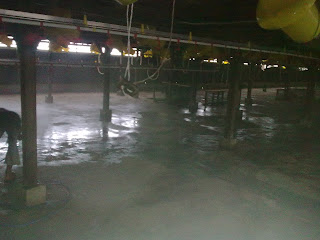EM™ Mudballs are made of dried mud into which EM™ Bokashi and Activated EM•1® have been kneaded. They are used to clean up bodies of water such as rivers, lakes, and oceans where there are concentrated deposits of sludge and slime.
How to make EM™ Mudballs
Basic Materials:
- Dirt. It is usually best to use clay-like dirt that can easily be formed into balls.
- Activated EM•1® (AEM).
- Molasses (At 10% the volume of the Activated EM•1®. For example, use 7 Tbs of molasses for 1 liter/quart of Activated EM•1®.)
- EM™ Bokashi.
- EM·X® Ceramics Powder. (In Japan, EM Super Cera® Ferment C or Terra C is used.)
How to use EM™ Mudballs
- Use EM™ Mudballs in river bottoms and mud flats where slime has accumulated. Use one EM™Mudball for each square meter of surface area.
- Use EM™ Mudballs once each season until results are seen.
- Cleaning up oceans, rivers, lakes and ponds requires the application of EM™ into the water through a variety of methods. It is recommended that Activated EM•1® also be regularly applied into the water to supplement the use of EM™ Mudballs.
Ratio of materials
- When using dirt only: 10 parts dirt + Activated EM•1® (AEM) + EM·X® Ceramics Powder (optional).
- When using dirt and EM™ Bokashi: 8 parts dirt to 2-4 parts EM™ Bokashi + Activated EM•1® (AEM) + EM·X® Ceramics Powder (optional).
- 8 parts dirt to 1-3 parts EM™Bokashi + Special EM™ Bokashi for EM™ Mudballs + Activated EM•1® (AEM) + EM·X® Ceramics Powder (optional).
- When using dirt and mud from mud flats: 5 parts dirt to 5 parts mud flat mud + Activated EM•1® (AEM) + EM·X® Ceramics Powder (optional).
- When using dirt and mud from mud flats and EM™ Bokashi: 9 parts dirt to 9 parts mud from mud flats + 1 part EM™ Bokashi + Activated EM•1® (AEM) + EM·X® Ceramics Powder (optional).
Note:
- Since the water content of the dirt and mud used will vary, the amount of Activated EM•1® (AEM) will vary as well. As a general rule, though, if for instance you produce 3.5 – 4 gallons of material you will need approximately 1 liter/quart of Activated EM•1® (AEM). Always be sure to have enough Activated EM•1® (AEM) on hand in case it is needed. If you use it up, you can add extra water instead (don’t be afraid to use a lot of Activated EM•1®).
- The amount of optional EM·X® Ceramics Powder will be between 0.5-1.0% of the total amount. For example, for 2.5 gallons of material this will equal 3.5 – 7 Tbs of EM·X® Ceramics Powder.


























